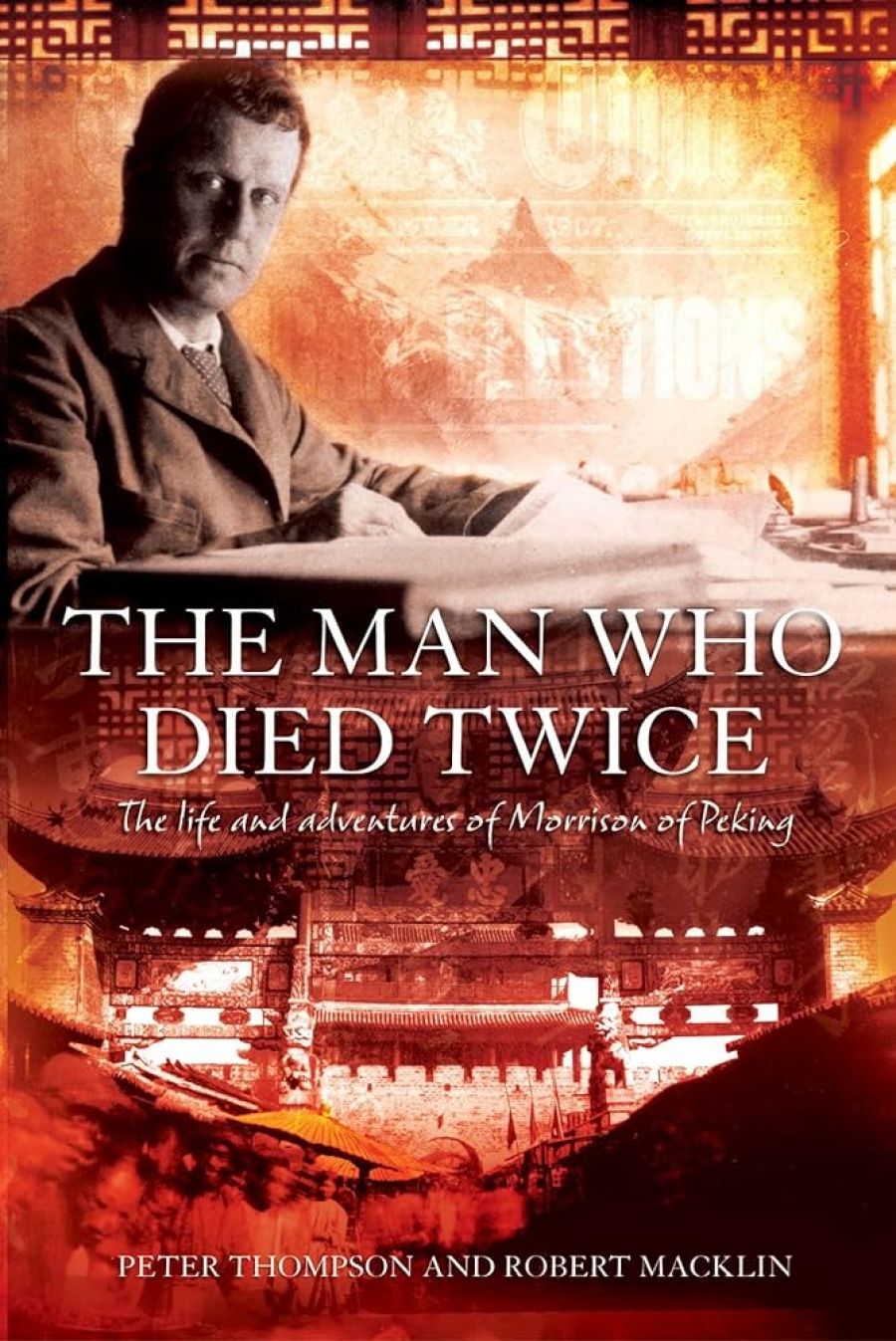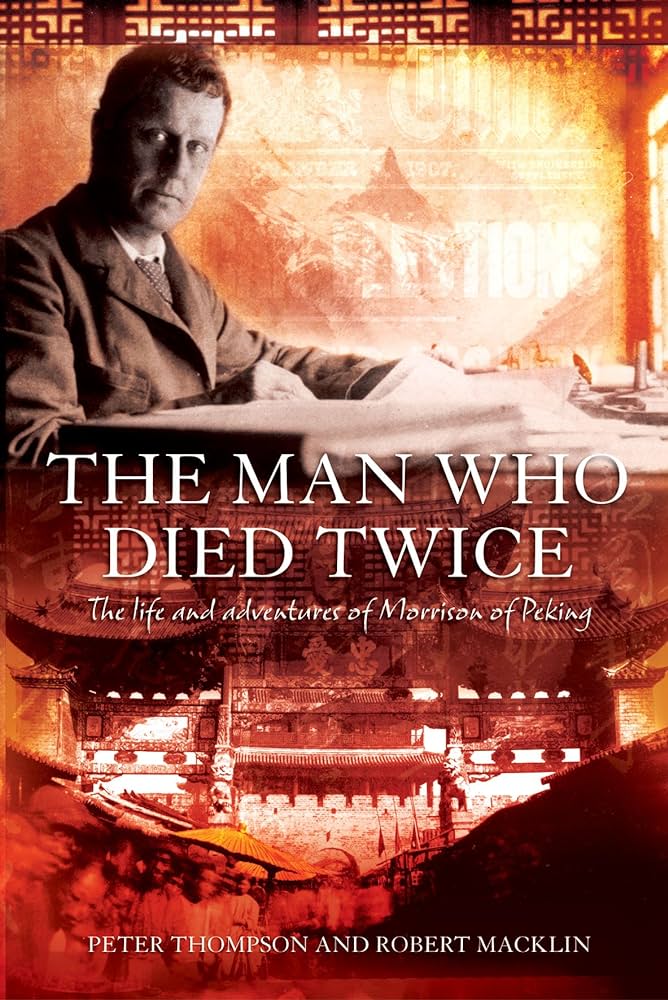
- Free Article: No
- Contents Category: Biography
- Custom Article Title: Straight Reporting
- Review Article: Yes
- Article Title: Straight Reporting
- Online Only: No
- Custom Highlight Text:
Between the ages of twelve and seventeen, the name Morrison seemed to be almost everywhere I looked. Scraping and stumbling through Geelong College, I attended assemblies in Morrison Hall, was a member of Morrison House, and daily passed a trophy cabinet in which was exhibited a copy of Morrison of Peking (1967), Cyril Pearl’s biography of George Ernest ‘Chinese’ Morrison (1862–1920), a scion of the founding family in whom its pride was visible.
It would be nice to say that the example of Morrison’s life spurred me to tackle journalism, what he called ‘the noblest of all the professions’, with its emphasis on ‘energy, courage, temperance and truthfulness’. But truth be told, he was at the time a little too exotic to take in – as Peter Thompson and Robert Macklin put it in their new biography, ‘a Scot by breeding, an Australian by birth and experience, British imperialist by choice and a Sinophile by compulsion’. Only later did I find myself bewitched by An Australian in China (1895), the vivid pedestrian’s panorama that Morrison wrote about his foot slog from Shanghai to Rangoon, which became, as it were, his successful job application to The Times.
- Book 1 Title: The Man Who Died Twice
- Book 1 Subtitle: The life and adventures of Morrison of Peking
- Book 1 Biblio: Allen & Unwin, $32.95 pb, 380 pp
- Book 1 Cover Small (400 x 600):

- Book 1 Cover (800 x 1200):

The time, Thompson and Macklin contend, is ripe for a new assessment of Morrison: ‘Everywhere the journalist is denigrated, the tenets of his or her vocation deliberately despoiled.’ Here, by contrast, was a journalist alieni generis, whose career was replete with laurels on which he nonetheless declined to rest, who developed an unappeasable curiosity about the Chinese people and an unequalled intimacy with their political leaders. He was the Occident’s foremost interpreter of the Orient in a time of unexampled turmoil, then, as a political adviser, helped translate the Chinese republic from theory to practice. He even, as it were, cheated the grave. After a false report of Morrison’s death amid the chaos of the Boxer Rebellion, The Times ran a fulsome obituary – thus, the title that Thompson and Macklin have chosen.
Unfortunately, it is with the title that the problems of this book begin. Morrison is hardly the first man to have had his death mistakenly reported and, like most of them, it is far from the most important aspect of his life and his career: no matter how familiar the sentiment, for instance, you wouldn’t call a biography of Mark Twain The Man Whose Death Was Exaggerated. The title really sums up the besetting difficulty of trying to slim Morrison’s life down to a tale of derring-do, to transform a man who ‘was to journalism what Don Bradman was to cricket’ into ‘an icon of inspiration’ for the modern media. It prefigures what is not so much a biography as a res gestae, and, as such, rather a disappointment.
Morrison offers biographers an improbably rich lode to mine, both in his public deeds and his private distractions: the former poured into profusions of journalism; the latter charted in a diary of Boswellian candour, kept from his teens until his death and a voluminous personal correspondence edited by Hui-Min Lo (1976). Pearl got the scoop, as it were: Morrison of Peking revealed that its subject’s personal entanglements were as torrid as his political ones. The challenge for Morrison’s next biographer was always going to be to do that bit more, delve that bit deeper; but it is a challenge that The Man Who Died Twice largely funks. There is the speculation that ‘devotion to his mother was the problem’, and that Morrison suffered from ‘the Madonna / whore syndrome’, meaning that he could ‘relate sexually only to loose women’, but no more. It sounds more like amateur psychology than the subtle, textured, nuanced reading encountered in the best biography, and not all that convincing, either. Madonnas and whores seem to have come alike to the guileless Morrison, who continued to extol the virtues of one incorrigibly promiscuous mistress (‘sweet and pure if ever there were purity and sweetness in a woman’) even as she strolled off and married another man.
We’re left with a straightforward sequential retelling of the events in Morrison’s life, which are, of course, greater and grander and wilder than most: at seventeen, he ambled from Geelong to Adelaide; aged twenty-one, he walked Australia from north to south. But this does condemn The Man Who Died Twice to a ‘then-he-did-this, next-he-did-that’ structure that barely changes pace and never alters tone. We study Morrison across a fixed, reverential distance, mostly from behind, seldom from the side, and almost never from the front, so that we might look back and glimpse where he has been.
Occasional parenthetic observations do not much deepen one’s sense of the subject. At one point, for example, the authors seem to find something revealing about Morrison’s Anglo-Australianism: ‘In common with his parents, Morrison had started referring to the Mother Country as “home”.’ Well, yes: when he was born, his Scottish father had been in Australia five years and his Yorkshire-born mother three years. And Australians a century ago did regard Britain as ‘home’. There were no ambiguities about Morrison’s allegiances; he was a loyal Britisher. ‘I feel indignant when I read in the papers that I am pro-this or anti-that country,’ he once said. ‘I am an Englishman and all I think about and all that I desire to serve are the interests of my own country.’ The tensions were elsewhere in Morrison’s life, between his belief in the imperial project, love for the Chinese, suspicion of the Japanese, and sacred conception of journalism. ‘My one wish is to tell the truth as I believe it,’ he avowed. But in the end, for Morrison, one wish was not enough.
In some respects, Morrison’s career is an illumination of what a journalist can and cannot do. Morrison’s first great exposé, for example, in the halcyon days of David Syme’s Age, was of the Kanaka trade. Only twenty, he shipped aboard a Queensland slaver on patrol, and his eyewitness accounts provoked salvoes of response that were far from uniformly favourable. Queensland’s colonial secretary Samuel Griffith dismissed him as ‘a very young man, who does not bear a high reputation, and whose narratives need to be received with much caution’. Impatient to move to the next stage of their pageant, Macklin and Thompson leave it there: ‘The young reporter was satisfied he had made his point. It was time to move on.’ But there was more to it, and The Argus, Pearl recorded, advanced a criticism of journalism that is not without force: ‘It would strike every reader of his letters that, if his allegations were true, he should have sworn an information of murder or kidnapping against the offenders, and that by omitting to do so, he made himself an accessory to all the crimes he witnessed.’ And this seems to anticipate the dilemma on whose horns Morrison would find himself time and again in China. For a journalist, it is usually deemed sufficient to bear witness to suffering; but what if the human urge to intervene, aid and redeem is too strong? Morrison felt this pang acutely, choosing finally, in 1912, to leave The Times for the circle of Yuan Sh-k’ai, general of the Newly Created Army then ushering the Manchu dynasty into extinction. Only later would he realise that as a correspondent he had enjoyed ‘twice the prestige and three times the influence’ of a courtier. The irony of The Man Who Died Twice is that the authors have sidestepped the same confrontation: they have reported the story but no more.


Comments powered by CComment